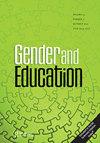Education policy and gender in Zimbabwe.
IF 2
3区 教育学
Q2 EDUCATION & EDUCATIONAL RESEARCH
引用次数: 44
Abstract
It is concluded that equality for women in education, which was a state aim in 1980, is no longer a state concern in Zimbabwe. It is argued that protection of the patriarchal order has been the operating principle of both colonial and post-colonial periods, and education is used to maintain the gender imbalance. Black women under colonialism were subjected to both sexism and racism. The socioeconomic order was maintained by ensuring that Blacks remained uneducated and unskilled. Colonial policy was race specific. Education was free and compulsory for Whites only. Black parents paid fees for a son's education. Post colonialism and in 1971, only 43.5% of Black children were enrolled in school, of which 3.9% were in secondary school. Only 19 girls with at the highest level in school. School curriculum was gender based, which meant girls were taught cooking and typing. During independence, education policy was instituted, and education was considered as a human right and gender neutral. Tuition fees in primary grades were eliminated, and education was expanded. However, changes after independence did not result in equal advantage for girls. By 1985-91, girls had lower enrollments at all grade levels. The widest gaps in enrollment were at the highest levels. School curriculum changed very little, and girls were directed to the "feminine" courses of study. Girls performed poorly in math and sciences. Girls were underenrolled in technical and vocational institutions. After 1989, structural adjustment programs negatively impacted on women. There was reduced access to employment, limited access to services, and increased demands on women's time in order to compensate for gaps created by cuts in services. New changes in education policy are expected to negatively impact on girl's education. Fees for primary school were reintroduced in urban areas, and secondary school fees were increased. The government dropped the requirement of certification for technical and commercial education, which could benefit the 64% of women employed in the informal sector. Export-oriented adjustment programs relied on cheap, low-skilled female employees.津巴布韦的教育政策和性别。
本文章由计算机程序翻译,如有差异,请以英文原文为准。
求助全文
约1分钟内获得全文
求助全文
来源期刊

Gender and Education
EDUCATION & EDUCATIONAL RESEARCH-
CiteScore
5.20
自引率
9.10%
发文量
31
期刊介绍:
Gender and Education grew out of feminist politics and a social justice agenda and is committed to developing multi-disciplinary and critical discussions of gender and education. The journal is particularly interested in the place of gender in relation to other key differences and seeks to further feminist knowledge, philosophies, theory, action and debate. The Editors are actively committed to making the journal an interactive platform that includes global perspectives on education, gender and culture. Submissions to the journal should examine and theorize the interrelated experiences of gendered subjects including women, girls, men, boys, and gender-diverse individuals. Papers should consider how gender shapes and is shaped by other social, cultural, discursive, affective and material dimensions of difference. Gender and Education expects articles to engage in feminist debate, to draw upon a range of theoretical frameworks and to go beyond simple descriptions. Education is interpreted in a broad sense to cover both formal and informal aspects, including pre-school, primary, and secondary education; families and youth cultures inside and outside schools; adult, community, further and higher education; vocational education and training; media education; and parental education.
 求助内容:
求助内容: 应助结果提醒方式:
应助结果提醒方式:


